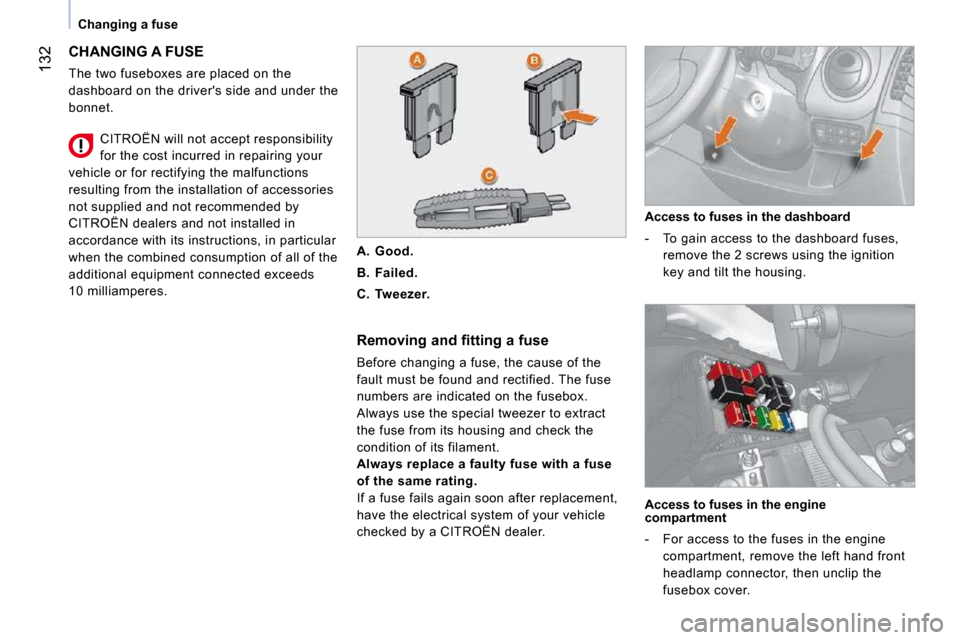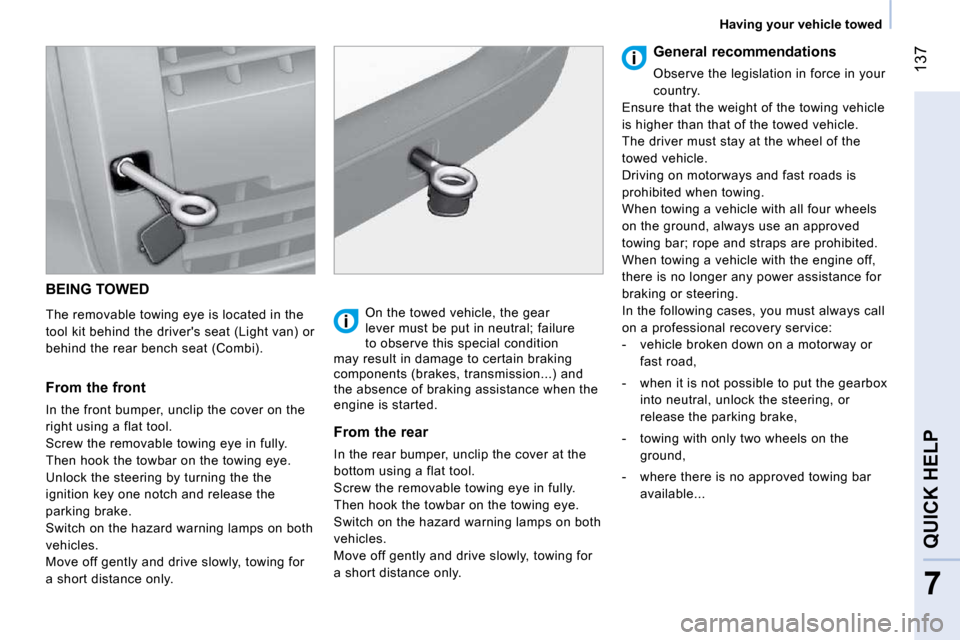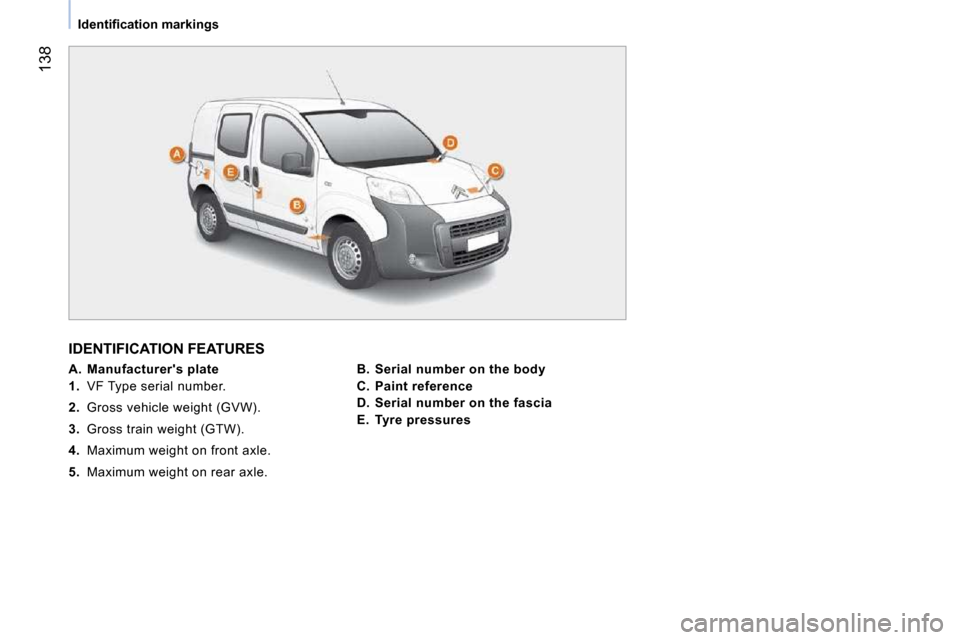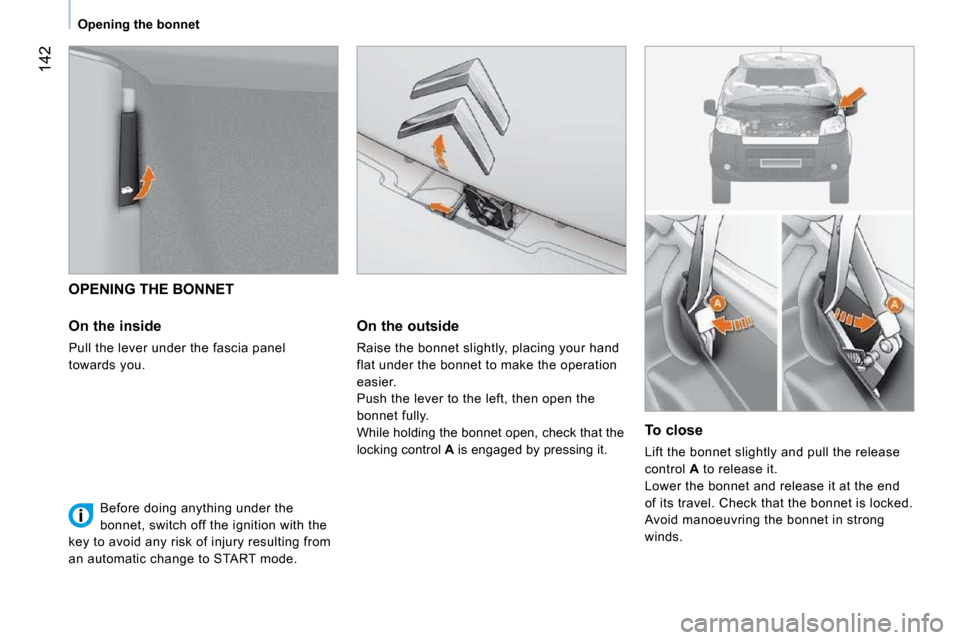Citroen NEMO 2010.5 1.G Owner's Manual
Manufacturer: CITROEN, Model Year: 2010.5, Model line: NEMO, Model: Citroen NEMO 2010.5 1.GPages: 166, PDF Size: 4.22 MB
Page 151 of 166

Changing a fuse
Marking Rating
Functions
F41 7.5 A Door mirror demisting.
F94 15 A Cigar lighter.
F96 15 A 12 V accessory socket.
F97 10 A Heated seat, driver's side.
F98 10 A heated seat, passenger's side.
Page 152 of 166

132
Changing a fuse
CHANGING A FUSE
The two fuseboxes are placed on the
dashboard on the driver's side and under the
bonnet. Removing and fitting a fuse
Before changing a fuse, the cause of the
fault must be found and rectified. The fuse
numbers are indicated on the fusebox.
Always use the special tweezer to extract
the fuse from its housing and check the
condition of its filament.
Always replace a faulty fuse with a fuse
of the same rating.
If a fuse fails again soon after replacement,
have the electrical system of your vehicle
checked by a CITROËN dealer. Access to fuses in the dashboard
- To gain access to the dashboard fuses,
remove the 2 screws using the ignition
key and tilt the housing.
CITROËN will not accept responsibility
for the cost incurred in repairing your
vehicle or for rectifying the malfunctions
resulting from the installation of accessories
not supplied and not recommended by
CITROËN dealers and not installed in
accordance with its instructions, in particular
when the combined consumption of all of the
additional equipment connected exceeds
10 milliamperes.
A. Good.
B. Failed.
C. Tweezer.
Access to fuses in the engine
compartment
- For access to the fuses in the engine compartment, remove the left hand front
headlamp connector, then unclip the
fusebox cover.
Page 153 of 166

135
7
QUICK HELP
Changing a fuse
Mark
ing Rating Functions
F01 60 A Control unit
F02 40 A Passenger compartment fan.
F03 20 A Starter motor supply
F04 40 A ABS hydraulic block pump supply
F06 30 A Single speed cooling fan control
F07 40 A High speed cooling fan control
F08 30 A Air conditioning compressor
F09 15 A Towbar harness.
F10 10 A Horn F11 10 A Engine management secondary load su pply
F14 15 A Main beam headlamps
F15 15 A 12 V accessory socket.
Table of fuses in the engine
compartment
Page 154 of 166

136
Changing a fuse
Marking Rating
Functions
F16 7.5 A Engine management control unit - e lectronic gearbox control unit and gear lever - T20 relay coil
F17 15 A Supply for ignition coil - injector s - engine management control unit (1.3 HDi)
F18 7.5 A Engine management control unit (1. 3 HDi) - T09 relay coil
F19 7.5 A Air conditioning compressor
F20 30 A Supply for heated rear screen, elec tric door mirrors heater elements
F21 15 A Fuel pump (1.4 petrol and 1.3 HDi)
F22 20 A Engine management control unit (1.3 HDi)
F23 20 A ABS hydraulic block electrovalves s upply
F24 7.5 A ABS
F30 15 A Foglamps
F81 60 A Pre-heat unit (1.3 HDi)
F82 30 A Electronic gearbox pump - electroni c gearbox supply
F84 10 A Electronic gearbox control unit and electrovalves
F85 30 A Cigar lighter - 12 V accessory sock et
F87 7.5 A
Reversing lamps - water in Diesel sensor - airflow
sensor - T02, T05, T14, T17 and T19 relay coils
(except 1.3 HDi)
5 A Reversing lamps - water in Diesel sensor - airflow
sensor - T02, T05, T14, T17 and T19 relay coils - battery
state of charge sensor (except 1.3 HDi)
Page 155 of 166

137
7
QUICK HELP
Having your vehicle towed
BEING TOWED
The removable towing eye is located in the
tool kit behind the driver's seat (Light van) or
behind the rear bench seat (Combi).
From the front
In the front bumper, unclip the cover on the
right using a flat tool.
Screw the removable towing eye in fully.
Then hook the towbar on the towing eye.
Unlock the steering by turning the the
ignition key one notch and release the
parking brake.
Switch on the hazard warning lamps on both
vehicles.
Move off gently and drive slowly, towing for
a short distance only. On the towed vehicle, the gear
lever must be put in neutral; failure
to observe this special condition
may result in damage to certain braking
components (brakes, transmission...) and
the absence of braking assistance when the
engine is started.
From the rear
In the rear bumper, unclip the cover at the
bottom using a flat tool.
Screw the removable towing eye in fully.
Then hook the towbar on the towing eye.
Switch on the hazard warning lamps on both
vehicles.
Move off gently and drive slowly, towing for
a short distance only. General recommendations
Observe the legislation in force in your
country.
Ensure that the weight of the towing vehicle
is higher than that of the towed vehicle.
The driver must stay at the wheel of the
towed vehicle.
Driving on motorways and fast roads is
prohibited when towing.
When towing a vehicle with all four wheels
on the ground, always use an approved
towing bar; rope and straps are prohibited.
When towing a vehicle with the engine off,
there is no longer any power assistance for
braking or steering.
In the following cases, you must always call
on a professional recovery service:
- vehicle broken down on a motorway or fast road,
- when it is not possible to put the gearbox into neutral, unlock the steering, or
release the parking brake,
- towing with only two wheels on the ground,
- where there is no approved towing bar available...
Page 156 of 166

138
� � � �I�d�e�n�t�i�fi� �c�a�t�i�o�n� �m�a�r�k�i�n�g�s� � �
IDENTIFICATION FEATURES
A. Manufacturer's plate
1. VF Type serial number.
2. Gross vehicle weight (GVW).
3. Gross train weight (GTW).
4. Maximum weight on front axle.
5. Maximum weight on rear axle.
B. Serial number on the body
C. Paint reference
D. Serial number on the fascia
E. Tyre pressures
Page 157 of 166

139
7
QUICK HELP
Fuel
FILLING WITH FUEL
Capacity of the fuel tank: approximately
45 litres .
Low fuel level
When the minimum fuel tank level
is reached, this warning lamp
comes on. When it first comes on,
you have approximately 6
litres
of fuel remaining. Refuel without delay to
avoid running out of fuel. Refuelling must be done
with the engine off.
- Open the fuel filler flap.
- Hold the filler cap with one hand.
- With the other hand, insert the key, then turn it a third of a turn.
� � �-� � �R�e�m�o�v�e� �t�h�e� �fi� �l�l�e�r� �c�a�p� �a�n�d� �h�a�n�g� �i�t� �o�n� �t�h�e� �h�o�o�k�,� �l�o�c�a�t�e�d� �o�n� �t�h�e� �i�n�s�i�d�e� �o�f� �t�h�e� �fi� �l�l�e�r� �fl� �a�p�.� �
FUEL CIRCUIT DEACTIVATED
In the event of a serious collision, a device
automatically cuts off the fuel supply to the
engine and the vehicle's electrical supply.
It also triggers the automatic unlocking of
the doors and switching on of the courtesy
lights. A message appears on the instrument
panel display according to version.
Turn the key to the STOP position to prevent
discharging of the battery.
Check that there is no smell or leak of fuel
outside the vehicle.
With Stop & Start, never refuel with the
system in STOP mode; you must switch
off the ignition with the key. When the fuel filler flap is open, a
safety system prevents sliding of the
side door.
A label affixed to the inside of the flap
reminds you of the type of fuel to be used.
Opening the filler cap may cause a noise
resulting from the inrush of air. This vacuum
is quite normal and results from the sealing
of the fuel system.
When filling the fuel tank, do not continue
after the 3rd cut-off of the nozzle; this could
cause malfunctions.
After filling the fuel tank, lock the filler cap
and close the flap.
Page 158 of 166

139
7
QUICK HELP
Fuel
FILLING WITH FUEL
Capacity of the fuel tank: approximately
45 litres .
Low fuel level
When the minimum fuel tank level
is reached, this warning lamp
comes on. When it first comes on,
you have approximately 6
litres
of fuel remaining. Refuel without delay to
avoid running out of fuel. Refuelling must be done
with the engine off.
- Open the fuel filler flap.
- Hold the filler cap with one hand.
- With the other hand, insert the key, then turn it a third of a turn.
� � �-� � �R�e�m�o�v�e� �t�h�e� �fi� �l�l�e�r� �c�a�p� �a�n�d� �h�a�n�g� �i�t� �o�n� �t�h�e� �h�o�o�k�,� �l�o�c�a�t�e�d� �o�n� �t�h�e� �i�n�s�i�d�e� �o�f� �t�h�e� �fi� �l�l�e�r� �fl� �a�p�.� �
FUEL CIRCUIT DEACTIVATED
In the event of a serious collision, a device
automatically cuts off the fuel supply to the
engine and the vehicle's electrical supply.
It also triggers the automatic unlocking of
the doors and switching on of the courtesy
lights. A message appears on the instrument
panel display according to version.
Turn the key to the STOP position to prevent
discharging of the battery.
Check that there is no smell or leak of fuel
outside the vehicle.
With Stop & Start, never refuel with the
system in STOP mode; you must switch
off the ignition with the key. When the fuel filler flap is open, a
safety system prevents sliding of the
side door.
A label affixed to the inside of the flap
reminds you of the type of fuel to be used.
Opening the filler cap may cause a noise
resulting from the inrush of air. This vacuum
is quite normal and results from the sealing
of the fuel system.
When filling the fuel tank, do not continue
after the 3rd cut-off of the nozzle; this could
cause malfunctions.
After filling the fuel tank, lock the filler cap
and close the flap.
Page 159 of 166

140
Fuel
Re-activation
To set off again, restore the fuel supply and
the electrical supply manually:
- with the key in the STOP position, turn
the key to the RUNNING position,
- push the direction indicators control up fully,
- place it in the "Off" position,
- press the direction indicators control down fully,
- return it to the "Off" position,
- push it up fully again,
- return it to the "Off" position,
- press it down fully again,
- return it to the "Off" position,
- turn the key to the STOP position. Quality of the fuel used for petrol
engines
The petrol engines are perfectly compatible
with E10 type petrol biofuels (containing
10 % ethanol), conforming to European
standards EN 228 and EN 15376.
E85 type fuels (containing up to 85 %
ethanol) are reserved exclusively for
vehicles marketed for the use of this type
of fuel (BioFlex vehicles). The quality of
the ethanol must comply with European
standard EN 15293.
For Brazil only, special vehicles are
marketed to run on fuels containing up to
100 % ethanol (E100 type).
Quality of the fuel used for Diesel
engines
The Diesel engines are perfectly compatible
with biofuels which conform to current
and future European standards (Diesel
fuel which complies with standard EN 590
mixed with a biofuel which complies with
standard EN 14214) available at the pumps
(containing up to 7 % Fatty Acid Methyl
Ester).
The B30 biofuel can be used in certain
Diesel engines; however, this use is subject
to strict application of the special servicing
conditions. Consult a CITROËN dealer.
The use of any other type of (bio)fuel
(vegetable or animal oils, pure or diluted,
domestic fuel...) is strictly prohibited (risk of
damage to the engine and fuel system).
Page 160 of 166

142
Opening the bonnet
OPENING THE BONNET
On the inside
Pull the lever under the fascia panel
towards you. On the outside
Raise the bonnet slightly, placing your hand
flat under the bonnet to make the operation
easier.
Push the lever to the left, then open the
bonnet fully.
While holding the bonnet open, check that the
locking control
A is engaged by pressing it. To close
Lift the bonnet slightly and pull the release
control
A to release it.
Lower the bonnet and release it at the end
of its travel. Check that the bonnet is locked.
Avoid manoeuvring the bonnet in strong
winds.
Before doing anything under the
bonnet, switch off the ignition with the
key to avoid any risk of injury resulting from
an automatic change to START mode.